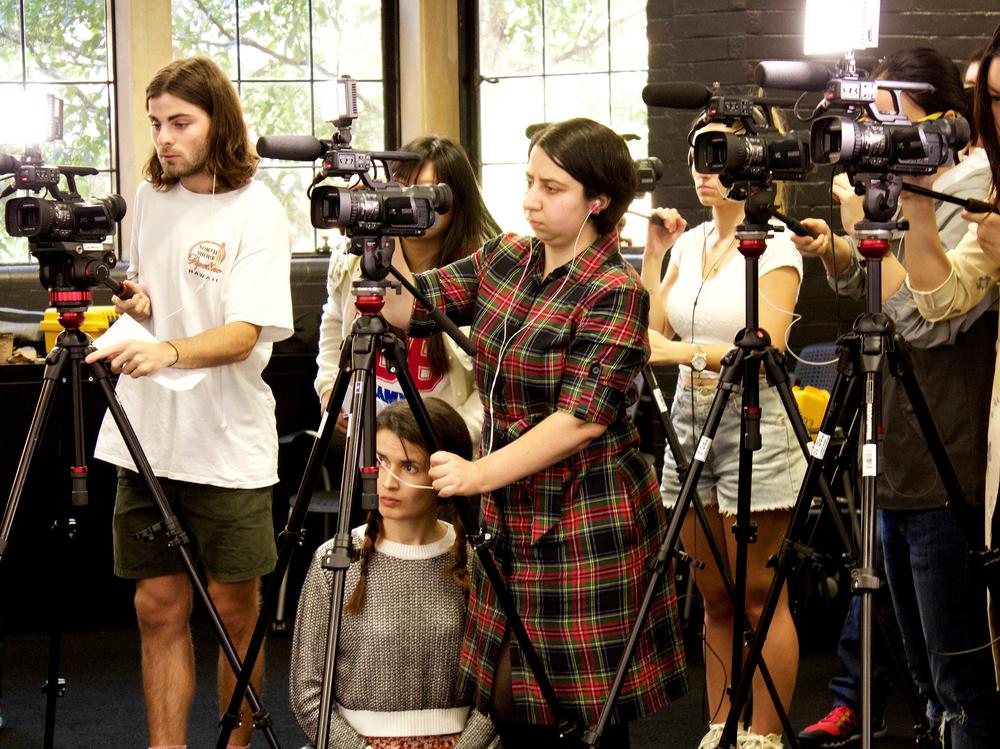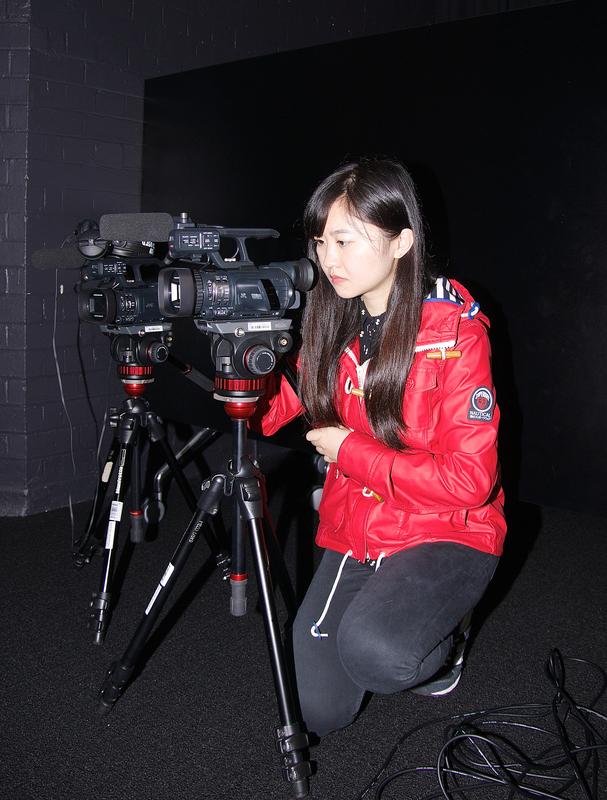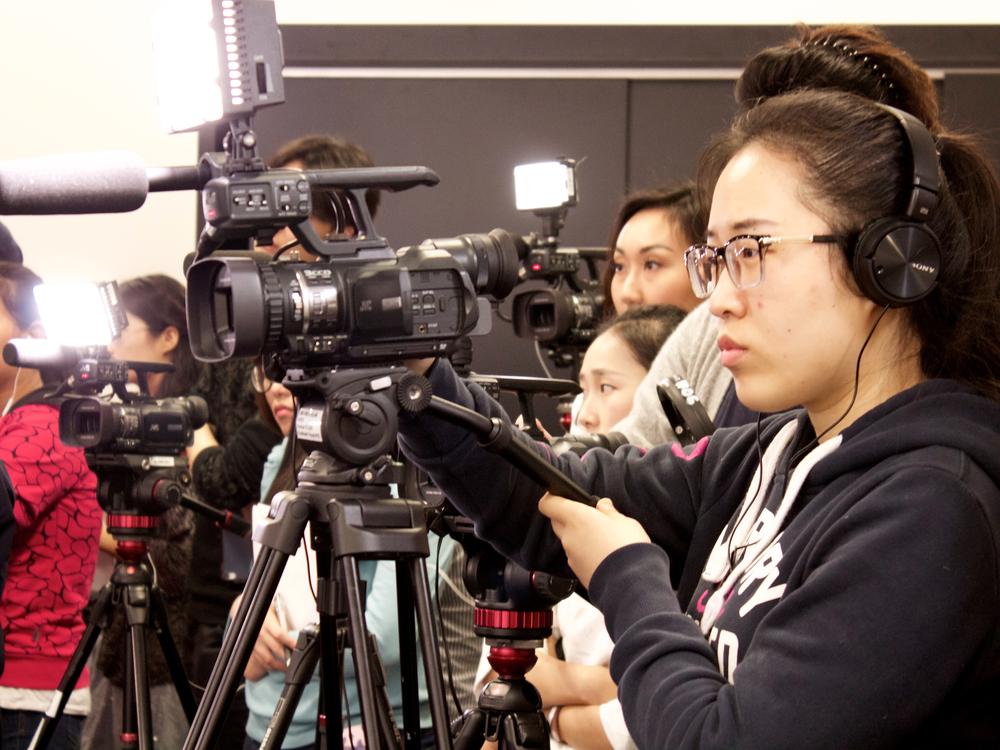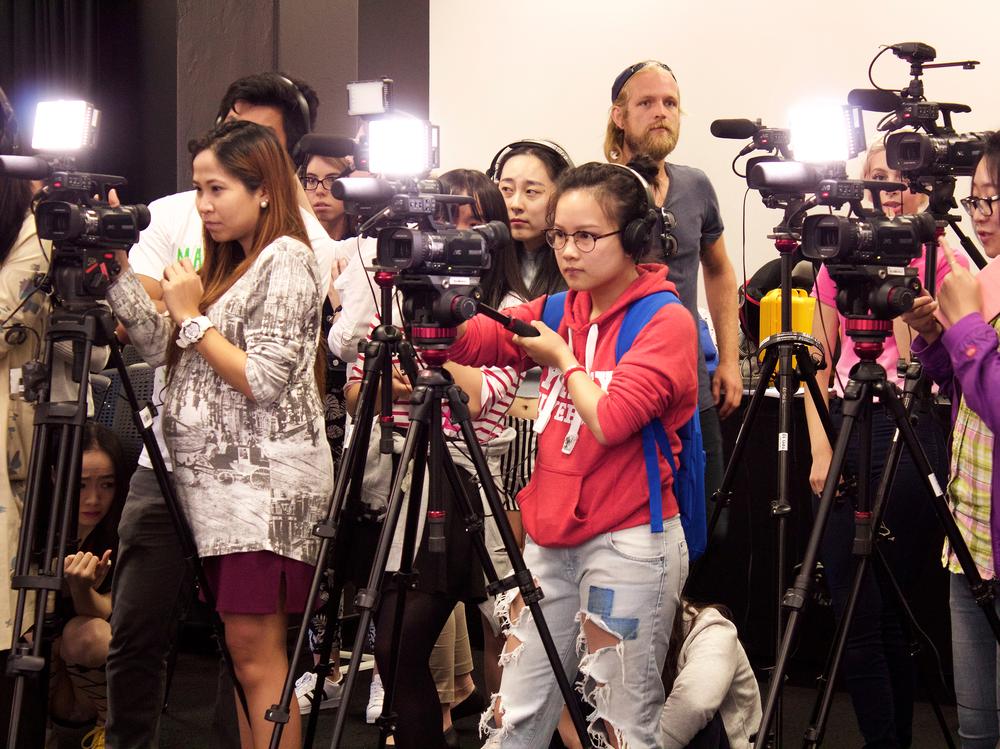9
Story-making in a global context: the Master of Media Practice
Story-making in a global context
Just as the first undergraduates were completing their degree, a new component of the MECO project was introduced: the Master of Media Practice (MMP). Like many master’s degrees, its purpose was to offer a postgraduate option for practitioners who wanted to upgrade their skills and for others who wanted to add to their skill set ahead of a career change. In 2004, its first year, 146 students signed up. Most of these enrolled in the full MMP, with some opting for the Graduate Certificate or Graduate Diploma pathways. Approximately 60 percent were domestic students and 40 percent international.
Within two years, the number of enrolments more than doubled. They held steady for a decade, and by 2017 were climbing again, more than tripling between 2017 and 2021. In 2013, international enrolments began outpacing domestic enrolments, and in 2021, more than 92 percent of those enrolled in the MMP program were international students.
MMP is now the second most popular postgraduate coursework offering in the Faculty of Arts and Sciences (just behind Economics) with nearly 1,200 students. What accounts for this extraordinary rise?
From the outset, one of the most remarkable features of the degree has been the way it situates media production in a global context. Anne Dunn had extensive experience working across print, television and radio media in Australia and the UK prior to joining the academy. She drew on this worldview when she devised MECO6926: International Media Practice as one of the degree’s four core units, which introduces postgraduate students to comparative study of media around the world. At a time when media education globally was predominantly Western-centric, Dunn’s reading list included case studies on media in China, Ghana, Lebanon and Mexico, as well as France, Sweden, the UK and the USA.
In 2008, Penny O’Donnell joined MECO as a senior lecturer in international media and journalism and took over as coordinator of this unit. She had extensive experience in international media, having graduated with an MA (Social Communication) with Merit, from the Universidad Iberoamericana in Mexico City; gained expertise in professional news media at ABC Radio (Sydney), Notimex (Mexico City) and Coradep (Managua, Nicaragua); and engaged in collaborative teaching on reconciliation, social justice and human rights at the University of Technology Sydney. She adapted the unit curriculum to engage the increasing global diversity of international students enrolling in the MMP. O’Donnell wrote an article for Synergy, the Institute of Teaching and Learning’s magazine, on the challenge of getting students to listen to each other and engage with unfamiliar or ideologically different points of view on global news issues. One student told her, “In the past, there was silence between us, now journalists are shouting at each other. Shouting is better than silence.”
International Media Practice quickly became, and remains, popular with both domestic and international students. O’Donnell says it is to Dunn’s credit that a review of the MMP, undertaken in 2017 by the Tertiary Education Quality and Standards Agency (TEQSA), concluded that a global media focus is a key part of what attracts the degree’s large and increasing number of international students.
The global media focus extends beyond International Media Practice into other core units. MECO6902: Legal and Ethical Issues in Media Practice focuses on Australia but, as unit coordinator Tim Dwyer explains, students engage with the material by comparing Australian media law, ethics, regulation and policies to American, European and Asian contexts. MECO6936: Social Media Communication, coordinated by Jonathon Hutchinson, emphasises the Southeast Asian digital communication environment and incorporates communication practices from First Nations peoples in Australia and other parts of the world.
Elective units also have a substantial global focus. One example is MECO6929: Chinese Media Studies in Global Contexts, coordinated by Joyce Nip. Another is MECO6925: Online Journalism. Unit coordinator Fiona Martin teaches this unit with “the aim of developing curiosity, empathy and cultural competence” in her students. To this end, she explains, “I encourage students to bring examples of compelling journalism from their own countries and cultures, and to talk about why it communicates effectively with different types of audiences.” Martin invites students “to report on issues that affect their everyday lives, and so they cover topics like rent and wage exploitation of international students, working visa policy and application challenges, political surveillance and human rights abuses – even the ethics of adopting rescue pets on student visa”.
Students in Alison Ray’s elective MECO6924: Video and Television Journalism are also acting as citizen journalists. They are learning to research, shoot and edit video news stories using formats that are commonly recognised in Europe, the Americas, Asia and Australia. And, as Ray explains, students are using current 4K and HD production technology so they can “reflect on how their work fits within a broader international context of newsgathering and broadcast operations”.
The TEQSA review highlighted another reason students have been attracted to the degree: the choices afforded them by the range of topics of study on offer. This was true in the degree’s first decade and was consolidated by a curriculum overhaul that began in 2015.
From 2004 to 2014, MMP candidates were required to complete 48 credit points, including 24 credit points of core units (News Writing, Dealing with the Media, Legal and Ethical Issues in Media Practice, and International Media Practice) and 24 credit points of elective units. Students could choose from MECO electives on topics such as literary journalism, public relations, sports reporting, political journalism, broadcast journalism and online journalism. They could also opt for electives from other disciplines such as Asian Studies, Film Studies, the United States Studies Centre, and Gender and Cultural Studies. As the TEQSA review observed, students were learning that successful content creation was a combination of professional skills, media theory and the development of “political, social, cultural and economic perspectives of the kind that the media are responsible for presenting to the public”.
Gang Shen was an MMP student during these early years. He completed the degree in 2010 and is currently the director of the media centre of the International Finance Forum, a China-based international organisation for financial communications. He tells us that the MMP taught him “the essential knowledge for future research in mass communications” and “embedded the most important values in [his] mind: pursuing facts and truth and always working for the interests of the people and society”.
Victoria Ong graduated from the program in 2014. She highlights her internships, including one with Nine News that had her conducting vox pops in Sydney’s CBD. Experiences like this developed the “skills and confidence to venture into the demanding world of broadcast journalism and eventually venture out on my own,” Ong says. After nearly four years working as a journalist and producer with Channel NewsAsia, she is currently an independent journalist, host and moderator.
Peter Charley is another 2014 alumnus. Between 2011 and 2014, he studied part-time while working as executive producer of Dateline on SBS. Prior to that, he had been the executive producer of the ABC’s Lateline. In late 2014, Al Jazeera approached him with an offer to take charge of their operations in North and South America. He tells us the MMP was “a highly valuable document” in their eyes. After seven years in Washington, DC, he is now based in Doha and manager of Al Jazeera’s Investigative Unit. This means he is second in charge of the network’s global investigative content, working under the director of the Investigative Directorate.
When we ask Charley how the MMP has contributed to his success, he tells us it “gave me fresh new perspectives on the media. Amongst other things, it helped me understand how the gathering and dissemination of information can be viewed through an academic lens – an entirely different take on the packaging of news and current affairs than I had experienced as a working reporter and producer.”
In 2015, with Tim Dwyer as degree director and Fiona Giles as department chair, the credit point requirement jumped to 72. Students were now required to complete 24 credit points of core units, a maximum of 42 credit points of elective units and at least 6 credit points of capstone units. The 12-month full-time program that Shen, Ong and Charley completed became an 18-month program. Students were still learning media skills through the lenses of media theory and multidisciplinary knowledge, but the parameters of these skills and the depth of these lenses had increased.
The four core units remained the same and, from 2015, MECO electives were added covering financial and investor communication, health communication, social media communication, theoretical traditions and innovations, interviewing and research methods. Electives were also added from the Sydney College of the Arts, enabling MMP students to undertake units on sound design, photomedia and digital editing.
In the first year of the revamped degree, students could choose from three capstone units: MECO6904: Dissertation, MECO6928: Media and Communications Internship and MECO6935: Professional Practice. While the dissertation and internship had previously been electives, the professional practice unit was new. As Dwyer explains, formalising these units as capstones, and adding the third option, represented three complementary pathways for students. The dissertation offered a research track; the internship was focused on the workplace; and the professional track was “designed to enhance employment options for students through undertaking in-depth reports relevant to their own career interests”.
Dwyer locates the tripling of MMP enrolments that occurred between 2017 and 2021 within a “uni-wide narrative” of increasing international student numbers. But the enhanced offerings following the degree restructure – and the steady honing since – have certainly played a part too. Dwyer names MECO6941, a podcasting elective introduced in 2018, as one example of the ongoing ways the degree is responding to “evolving media practices in platformised and social media app contexts”.
Lea Redfern is behind MMP’s evolution into podcasting. She tells us Megan Le Masurier proposed the idea for the elective and thinks it may have been the first postgraduate unit dedicated to podcasting at a university, in Australia or elsewhere. Redfern worked with independent podcaster Gretchen Miller to create the course content and has been coordinating the unit since its launch. In the first year, more than 100 students enrolled. Tina Matalov was the unit’s original demonstrator, working alongside tutors in a role akin to an industry sound engineer. Redfern says she was “instrumental in creating a foundation of curiosity and fun within the course”. Matalov now works at LiSTNR.
Olivia O’Flynn was one of Redfern’s students in 2019. Since then, she has been nominated for three Australian Podcast Awards and, in 2021, was included in Radio Today’s 30 Under 30 Awards. She is partner manager for the Creator Network in Australia and New Zealand at Acast, which, she explains, involves “developing thought-leading formulas to drive podcast growth and understand audience behaviour”. This year, O’Flynn was invited to sit on the judging panel for the Australian Podcast Awards. She credits MECO6941 with allowing her “to experiment and understand the medium of podcasting in a supported environment” and is grateful for the “lasting effect” of “Lea Redfern’s pearls of wisdom and her generosity in sharing knowledge”.
Enrolments in MECO6941 have increased each year, exceeding 500 in 2022. When we ask Redfern how she accounts for this popularity, she proposes a few reasons. Foremost is that the unit “is taught almost exclusively by industry professionals who bring their rich experience and delight in audio to the classroom”. Students also appreciate that it is a production unit, which means they are becoming familiar with new technology and gaining industry skills they can bring into the workforce. Their final assignment is to create a short podcast to broadcast standard, and they conclude the unit with “a real sense of achievement”.
Students soon began asking for more, and in 2022 Redfern introduced MECO6947: Advanced Audio Project. This established another capstone option for MMP students, following on from the addition of MECO6932: Advanced Media Project (added in 2019) and MECO6946: Industry Research Project (added in 2021).
In the past few years, the degree has also added electives in publication design and managing social media communities. In 2019, the elective MECO6936: Social Media Communication replaced MECO6901: Dealing with the Media as one of the four core units. Bunty Avieson, who was degree director at the time, instigated the move as a response to the TEQSA review. The review noted the PR-oriented Dealing with the Media was in need of updating (it’s since been renamed Media Relations and remains an elective) and saw an opportunity to add a core unit “addressing audiences and content creation and analytics across platforms, especially emerging digital ones”.
The degree looks quite different than it did in 2004. The program and its units have evolved in response to a dynamic mediascape and ballooning enrolments. What remains at its core, though, in Avieson’s words, is “telling stories about people. And those stories still have to be well told.” Over the past two decades, more than 6,000 students have completed the degree. They have learned to create well-told stories about people across print, audio, video and multimedia modes, and they have learned to situate their story-making in professional, theoretical and global contexts. They have learned to put media into practice.



